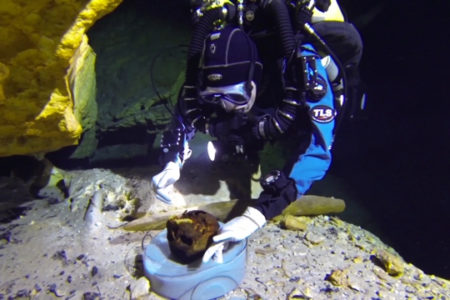Caves fascinate people. I visited Carlsbad Caverns in New Mexico as a kid when my family was on a summer vacation. Maybe that early exposure to the wonders of what geologic processes can do helped influence my decision to study natural science in college.
With any luck, you have been in a big cave at some point and maybe you have exposed a kid or two to the wonders of these sometimes enormous holes in the rocky rind of our planet. Some of the interesting features of certain caves are the column-like attributes that hang down from the ceiling and are built up from the floor. Stalactites (the objects hanging from the ceiling) and stalagmites (the complimentary columns going up from the floor) grow slowly. Humans have known of their existence since time immemorial, but it is only in recent years we’ve realized they have a story about climate to tell us. Here’s the scoop about how cave features speak to certain abrupt changes in climate.
As reported recently in Science Express, researchers led by a team at the Georgia Institute of Technology studied four stalagmites from Borneo. The stalagmites are made of calcite, a relatively soft mineral made of calcium, carbon and oxygen. (If you have ever played around with mineral identification, you will remember calcite as the crystal that bubbles vigorously with gas when you drop a little dilute acid on it.) It is estimated that the stalagmites in Borneo grow at a rate of about three eighths of an inch every thousand years.
Stalactites and stalagmites grow in caves because the rainwater of a region penetrates the ground, dissolving a little bit of mineral matter as it moves. When it gets to a cave, the water drips down from the ceiling and onto the floor of the cavern. Just a little at a time, minerals like calcite are precipitated as a solid when the water evaporates a smidgen. Over the ages, features like stalactites and stalagmites can become very large. The ones in Borneo grew over the course of 100,000 years.
What is especially interesting about the Borneo stalagmites is that the calcite in them has variations in the oxygen atoms found in the calcite. Different oxygen atoms on Earth have different atomic weights. The differences in the oxygen weights in the stalagmites reflect different oxygen atoms in the groundwater of an area. That, in turn, is a function of variations in oxygen weights of rainwater that fell in Borneo over millennia.
The researchers investigating the stalagmites cut them lengthwise in half. They then took small samples at the center of the stalagmites less than an eighth of an inch apart. The samples represented 60-200 years of growth apiece. They show two things: the rainwater of Borneo was influenced by the rapid climate change patterns known from the North Atlantic and called Heinrich events. But the Borneo samples do not show evidence of being influenced by a different set of rapid climate change events, those called the Dansgaard-Oeschger oscillations.
What is important about the samples from Borneo is that we have not had much evidence about climate change from the tropics. We know a lot about natural climate change from studying ice cores from Greenland and Antarctica, but we have had much less clear evidence of climate variations from low latitude regions.
Other turns in history show up in the stalagmites. They show changes in their oxygen weights when the mega-volcano in Indonesia at Lake Toba erupted around 75,000 years ago. Those were dark days throughout the region and weather was affected as shown by the stalagmite record.
The take-away lesson about the stalagmite record in the tropics is similar to what we see in the ice core records at the poles of the planet. We may well not like it, but climate is a fickle business. Change is woven into the warp and weft of Earth processes, and climate is always changing both in terms of precipitation and temperatures. In short we are riding a bucking bronco and we have recently added to the risks we face by perturbing the greenhouse gas concentrations in the atmosphere.
Hold onto your hats!






